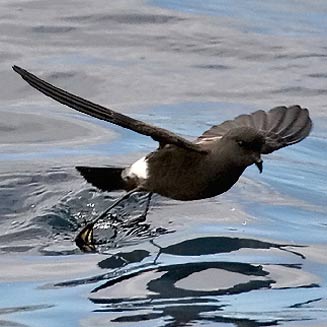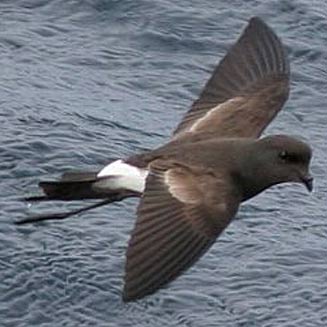|
Oceanites oceanicus (Wilson's
storm-petrel)
Gewone stormswael, Geelpootstormswael [Afrikaans]; Wilson-stormvogeltje
[Dutch]; Océanite de Wilson [French]; Buntfuß-sturmschwalbe [German];
Painho-casquilho [Portuguese]
Life
> Eukaryotes >
Opisthokonta
> Metazoa (animals) >
Bilateria >
Deuterostomia > Chordata >
Craniata > Vertebrata (vertebrates) > Gnathostomata (jawed
vertebrates) > Teleostomi (teleost fish) > Osteichthyes (bony fish) > Class:
Sarcopterygii (lobe-finned
fish) > Stegocephalia (terrestrial
vertebrates) > Tetrapoda
(four-legged vertebrates) > Reptiliomorpha > Amniota >
Reptilia (reptiles) >
Romeriida > Diapsida > Archosauromorpha > Archosauria >
Dinosauria
(dinosaurs) > Saurischia > Theropoda (bipedal predatory dinosaurs) >
Coelurosauria > Maniraptora > Aves
(birds) > Order: Ciconiiformes
> Family: Hydrobatidae
 |
 |
|
Wilson's storm-petrel. [photo
Jeff Poklen
©] |
Wilson's storm-petrel, offshore from Cape Town, South Africa. [photo Trevor Hardaker ©] |
Distribution and habitat
Breeds in ice-free areas of Antarctica, the sub-Antarctic
islands and islands around the Cape Horn of South America. It disperses in the
non-breeding season across all seven of the oceans of the world, including much
of southern African waters, travelling closer to the coastline than most other
storm-petrels. It is most commonly seen along the border between the continental
shelf and the deep ocean shelf.
Predators and parasites
At its breeding colonies it has been recorded as prey of
giant-petrels (Procellariidae) and skuas (Catharacta).
Movements and migrations
Most leave the breeding colonies in the period
from March-May, which is also when its numbers peak in southern
African waters. Here it is present year-round, however many birds
return to their colonies around October-December.
Food
Its diet in southern Africa is not as well known as in its
breeding colonies, where it mainly eats planktonic crustaceans supplemented with
fish, squid and carrion. It mainly forages by taking prey from the water surface
(submerging its head and neck), often "walking" on the water beforehand while in
flight (see photo on the top right). The following food items have been recorded
in its diet in southern Africa:
- zooplankton
- small squid
- Lampanyctodes hectoris (Lanterfish)
- fishery waste
Threats
Not threatened, in fact it has a global population of
several million pairs. Its breeding colonies have however been negatively
effected by the introduction of Domestic cats (Felis catus) and rats (Rattus),
which eat eggs and chicks.
References
-
Hockey PAR, Dean WRJ and Ryan PG 2005. Roberts
- Birds of southern Africa, VIIth ed. The Trustees of the John Voelcker
Bird Book Fund, Cape Town.
|
